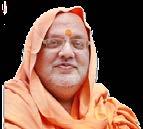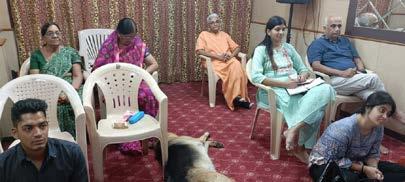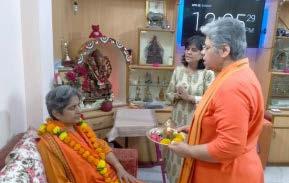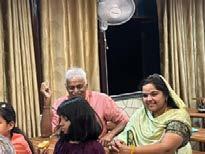Vedanta Sandesh

Monthly eMagazine of Vedanta Ashram & Mission
June 2023 Issue 12 Year 28
The cover page picture of June 2023 of Vedanta Sandesh is a beautiful photo of the shy & colorful ‘Indian Pitta’. It is locally called as Navrang, meaning the nine-colored bird. Its scientific name is Pitta brachyura.

This bird has long, strong legs and a stout bill, a buffy crown with a black stripe in the middle, a black eye-stripe, and and buffy underparts with bright red on the vent. Upperparts are green, with a blue shoulder patch. It is usually seen foraging on forest floors with thick undergrowth, catching insects in leaf litter. This bird is vocal, giving its characteristic two-noted whistle call at dusk and dawn. Indian Pitta is native to the Indian subcontinent. It breeds in the forests of the Himalayas, hills of central and western India, and migrates to other parts of the peninsula in winter.
Getting an opportunity to see & hear it in the shrubby forests is indeed a wow experience and thus is an Avian Vibhooti, that which spontaneously makes us remember their awesome divine creator.
Om Tat Sat


Published by Vedanta Ashram, E/2950, Sudama Nagar, Indore-452009 (M.P.) India http://www.vmission.org.in / vmission@gmail.com Monthly eMagazine of the Vedanta Mission June 2023 : Year 28 / Issue 12 Editor Swamini Samatananda Saraswati
06 Message (Poojya Guruji)
11 Drig Drishya Viveka (Sw. Samatanandaji)
16 Art of Manmaking (Sw. Chinmayanandaji)

22 Jivanmukta (Tapovan Maharaj)
24 Story Section (The Sacrifice)
26 Photo Albums (Various Activities)
41 News (Mission & Ashram) 42
Vedanta Sandesh June 2023 CONTENTS 05
O Master, O friend of all who reverently surrender unto thee, thou ocean of mercy, I salute thee; save me, fallen as I am into this sea of worldly existence, with a direct glance from thy eyes which shower nectarine Grace Supreme.

5 nqokZjlalkjnokfXurIra nks/kw;ekua nqjn`"VokrS%A Hkhra iziéa ifjikfg e`R;ks% 'kj.keU;a ;nga u tkusAA
- 38
Vivekachoodamani
Message from Poojya Guruji
Moral of the Arjuna story in Gita

Moral of the Arjuna story in Gita
Focus on Principles:
It is interesting to note that the great Sri Adi Shankaracharya, while writing his Bhashya on Bhagwad Gita, initially writes an awesome introduction of Bhagwad Gita, thereafter skips the entire first chapter, and also the first 10 shlokas of the second chapter and just before the 11th shloka, where Bhagwan Krishna starts his teachings to Arjuna as a teacher, the Acharya starts his commentary once again. In this section, he himself says that there was something very important revealed in the story of Arjuna’s despondency and the subsequent grief. What is the ‘moral of the story’? We shall briefly discuss it here.

The Cause of Samsar:
The great Acharya is not overwhelmed or obsessed
by any great or powerful individuals mentioned in the first chapter but just discusses the principles involved in the story. He says that basically the story points out the ‘manifestation of a factor’ in the mind of Arjuna which turns out to be the basic root and cause of our getting caught in the whirlpool of endless seeking & transmigration - termed therein as ‘samsar’. This X factor raises its head, and thereafter Arjuna kept going down & down and comes to a very pitiable condition of grief and despondency, a very stressful state of mind which literally broke the great warrior, so much so that even before the enemy raised their weapons, the bow of Arjuna had already fallen off from his hand. Let us go into that terrible X-factor which could have been nipped in its very budding state if there was the right awareness of its disastrous consequences.
Arjuna was inspired by Dharma:



Vedanta Sandesh 7
Moral of the Arjuna story in Gita
Let us remember that as a true Kshatriya, Arjuna was sincerely dedicated to the well-being of his entire country and countrymen. This was after all a battle of principles within a ruling family as to who should rule the country & how. Both the parties had their values and ways of attaining their goals. All during his VanVaas, he was planning, dreaming, and preparing to root out the evil in his country. However, when the D-day came, something tripped, and he not only forgot all his magnanimous inspirations but rather started the downward slide into the abyss of grief and despondency. It is this tripping factor which has been basically revealed in the first chapter. This factor was responsible for changing his perception and priorities, and therefore it is extremely important that we identify that factor. The story of Arjuna is just a means to communicate that factor

which can manifest in any person in the world and bring about unimaginable and pathetic consequences.


Dharma is to live for the well-being of all:
The righteous attitude of Dharma is based on some fundamental facts, while the unrighteous behavior is based on imaginary and selfish presumptions. It is a fact that we were blessed with a human life, we got an awesome creation, running beautifully. The air, the sun, moon, food, dynamic and lively weather, our loved ones - we got all that on a hamper, without asking, on a platter. Thus the right attitude should be that we are messengers of God, everyone of us, and should work lovingly as wished by our benevolent master. That is what Dharma is all about. With the right education, we need to be inspired by the well-being of all. After all, the whole world is a family - intimately connected and collectively living as

8
“Arjuna’s story basically reveals the tripping point, the basic cause of the downward slide into the abyss of Moha and the consequent Shoka.
”
Moral of the Arjuna story in Gita
one unit. Here some people miss the bigger picture and start thinking and living just for me & mine. Their world becomes small, and goals petty. Those who are not in this me & mine are not only ignored but even abhorred. Wars, violence, murders, etc., become obvious & natural. So if we are aware of the consequences of these two possibilities, then we shall easily identify the tripping point in Arjuna’s mind.
Arjuna succumbed to Adharma:



Initially, Arjuna was different, but the moment he saw his relatives around, he as though succumbed to these emotional pressures and was concerned with just me & mine. All his initial motivations got sidelined and got overwhelmed by petty perceptions. This was the basic Mohathe wrong understanding. With Moha infecting our intellect, Shoka or grief alone follows. This is the universal problem, and thus the message is that till we all entertain the values & visions based on the magnanimous, fundamental & universal facts of life, till then the world shall keep getting inflicted & infected by never-ending grief and stress. The correction
required is simple and just in the domain of right knowledge.

Moha leads to Shoka:
What exactly happens when there is some fundamental misunderstanding or Moha about the basic facts of life & oneself? Obviously, there comes about a wrong and baseless understanding, and the problem with, let’s say, a non-existent disease is that no matter what treatment we give by the best doctors around, no cure will be there, simply because the problem is not there outside, it is there somewhere but not outside, and thus all efforts will be fruitless. Not only that, it will keep getting serious.
Vedanta Sandesh 9
Moral of the Arjuna story in Gita
There will be desperation and dejection. It is this which brings about helplessness, stress, and grief with all its associated problems, including diseases, sorrow, etc. So the Arjuna story tells us that wherever there is Moha, there will definitely be Shoka.
Shoka is removed by Gyana alone: The first tragedy with Moha is that the basic and heartfelt inspirations get sidelined or rather veiled by all the disturbance in the mind, and thereafter the person instead of looking within looks around and starts following anything which people around seem to do. Initially, when a person was following his or her love, then do-


ing karma itself was a matter of great joy, but now it is the fruits of actions which become more important, and all this is not done lovingly but with great effort. Finally, we have a society full of people who have no love or peace within and are blind emulators of the people around. Devoid of self-respect and dignity, they lead a thoughtless life. All this happened to Arjuna during the moments when he got inflicted with Moha. Like any disease, Moha can be handled - just by right knowledge.
This is the moral of the story of Arjuna in Bhagwad Gita.
Om Tat Sat.


Vedanta Sandesh 10
Meaning: Food is Brahma, the essence in it is Vishnu, and the one who consumes (enjoys) it is Maheshwar, the Lord Himself. If you know this, then any impurities in the food will not become a part of you (will not harm you).



véczãk jlksfo".kq% HkksDrk nsoks egs'oj%A ,oa KkÙok rq ;ks HkqaDrs vé nks"kks u fyI;rsAA
DRIG DRISHYA VIVEKA
Swamini Samatananda

vUr%dj.k:fi.khAA
Buddhi (Intelligence) appears to possess luminosity on account of the reflection of Consciousness in it. Buddhi is of two kinds. One is the designated ego the other as mind.

Shloka - 06
fpPNk;k·os'krks cqq)kS
Hkkua /khLrq f}/kk fLFkrkA
,dkgaÑfrjU;k L;kr~
Drig Drishya Viveka
Chitchhaya veshatau buddhau bhanam:

Sangati:
In the last verse the Revered Acharya concluded a section by pointing out the Sakshi as the ultimate Drishta of the individual personality which composed of the three fold ‘Seers’, namely the sense organs, the mind and the intellect. The Sakshi is revealed as the ultimate Seer which neither rises nor sets, which does not undergo any changes of growth or decay. It is the unchanging Self-luminous Consciousness. Having revealed this a question arises that if the Sakshi is the constant Reality, then how did this Jiva featured by the three Seers come into being? What is the nature and role of this existence? This topic has been taken up in the following shloka.
The story of Samsara is the story of the mind. This Samsara is a dream and this world of dreams has been created by the Mind. But how did the Mind get the potential to bring about this dream world? This dream that appears to be so Real. To explain this the Acharya saysThe Mind itself cannot become the Seer of anything because the mind is basically made up of the Panchmahabhutas which are inert by nature. The Mind is made up of the sattwa guna of the five elements. Then how does the Mind come alive and become the Drishta, the experience of everything around. We can understand this by the classic example of the Moon and the Sun. The Moon is able to lit up the
Who is a Jiva, and how does he manifest ?



Vedanta Sandesh 14
Drig Drishya Viveka


night but the truth is that the Moon is not self-luminous. It reflects the light of the Sun. Similarly the Mind being inert cannot enliven the sense organs and the various experiences by itself but the Mind reflects the light of Consciousness. Here the Sakshi can be compared to the Sun and the Mind is like the Moon. Reflected Consciousness is the ‘Chitchhaya’.
dhistu dwidha sthita: With the reflected consciousness the Mind undergoes two modifications. Here, for the sake of understanding the Acharya divides the Mind into two types of awareness.


Eka ahankritihi anyaasyad antahkaranarupini:
One is the Ahankritih that is the Ego and the other is the Mind which is the Antahkaranam. Antahkritih is the first wherein the Mind shines-its existence is known and the second this Mind as a subtle instrument enables the sense organs to enlighten the objective world. These two types of awareness come about effortlessly. Ahankriti is the sense of doership which is natural in all living beings and antahkarana is the thought part of the Mind. Both these dimensions are basically inert but become sentient because of the Reflected Consciousness. The Ahankara naturally reflects a sense of doership expressing the desire to experience the world and the thoughts pervade the objective world. Once these two come into existence the story of samsara begins.
Vedanta Sandesh 15
-63The Art Of Man Making
Pre-Meditational Care

P.P. Gurudev
Swami Chinmayanandaji
Pre-Meditational Care
Generally, we are afraid of meditation. These are days when it has become a fashion, and so the energetic youth is familiar with the term, “meditation”. And yet, deep in our mind we know we are afraid of it mainly because we know that it is hard to mas- ter, and not available for easy success. None of us want to under- take any programme which we know is sure to fail. We are indeed afraid of meditation.
In our habitual out-going mental tendency there is never a quiet moment when our mind is at rest, at peace with itself - ex- cept, perhaps, when we are in deep sleep. There cannot be even hopes for the preliminaries in meditation when the mind is in a riotous spree among the objects present, objects remembered from the past, and objects fancied for the future. And this is our only constant preoccupation in the state of our present existence.
Therefore, we need some re-adjustments and self-disciplines before we enter into the fields of meditation. If these




preliminary adjustments are brought about, then that mind can hope to enter into a mood of meditation, sufficiently consistent, that we can at least reach the early stages in our “attempts at meditation”.
A surgeon must prepare his patient for the operation. The patient has to undergo some necessary and essential pre-surgical treatments. Similarly, before we bring our minds to the seat of successful meditation, it has to be made worthy of it. We must bring our mind on to the “pad” of a quiet mind first, before rocket- ing it into the voiceless distances of the inner space. These “pre- meditational care and treatment” are many. A certain amount of intelligent self-review of our own life a critical life of others around us an intelligent peep into what the future would be if we move in the very direction we are at present pursuing these bring a vague yearning into our bosom.
Vedanta Sandesh 17
Pre-Meditational Care
The general picture of life and of its greater purpose elaborated so eloquently so far, in the five discourses of the Bhogawad Geeta should give any serious student an impatience with his own imperfections and his own incompetency in properly di- recting the current of his life from the wasteful sense-pursuits into the man-remaking, personality-re-building, creative endeavours of the spiritual life.

He would then demand a withdrawal of his mind from its habitual channels of desires and passions, and strive to turn its attention entirely into a profounder state of Consciousness.

We really shudder at our own inherent inability order to escape self-criticism and self-pity, we courageously cry down the spiritual life - we come to scream at all religions and in we vociferously glorify materialism and we noisily champion mere secular activities. We strive, earn, hoard, decay, and haplessly perish in
the very exhaustion of our own pithless pursuits, mean- ingless strifes, empty efforts, tearful fatigues, and unsatisfied year- nings. This is “escapism” - pure and simple, tragic and terrible, sad and calamitous.

This hesitation in the heart of any early seeker is natural and Krishna anticipates such a mental shyness in Arjuna, and so here the Lord spells out an easy and beautiful remedy: He who recognises me- as the dispenser of Yagnas and all penances- as the Great Lord of the world as the friend of all beings-he attains Peace. So easy and so very effective is this great remedy suggested by Krishna.
Mind naturally comes to meditate upon what it loves. For a lover, to ardently meditate or to continuously contemplate upon the beloved is no strain! Where there is love, there the mind auto- matically stays-even if
He who recognizes me as the dispenser of Yagnas and all penances, as the Great Lord of the world, as the friend of all beings-he attains Peace.
Vedanta Sandesh 18
Pre-Meditational Care

you draw the mind away from it, the mind would spring back to it again. A mind always gravitates towards the field of its love and fancy, its affection and tenderness. Therefore, if we discover that the Lord of the Universe ( सससससससससससससससस) is the prompter of all our inner thoughts and outer activities if we realise that this Divine Lord is not some awe-inspiring Omnipotent Sovereign Sultan of the skies-sitting in majestic glory some- where above the clouds - but that He is our pal ever with us help- ing us as a friend, philosopher and guide, then our tender affec- tions for Him would stem forth in us, and our mind would readily, in peace, rest in the contemplation of His nature, of His Love, of His Benevolence!


Carefully let us examine Krishna’s definition of the Self in us, functioning as the Lord of the Universe.

Geeta says that the Self in us is “the sole Dispenser of all Yagnas and of all ponances” (W). The Spark of life, the Consciousness in us is certainly the one factor that illumines all our receptions (4)and all our deliberate responses put forth to achieve anything (). If life is not in a being, both reception of stimuli (ar) and res ponse (a) become impossible. And the Self in everyone is the same. Thus, the Lord of all receptions in every bosom, and of all responses of all creatures is the Great Lord of the world (सससससससससससससससस ).
This mighty life in all hearts this glorious Power behind every action of all creatures this Lord of all Lords - must be a resplendent relentless entity, removed far away, perhaps, from our insignificant existence- too glorious and
Vedanta Sandesh 19
Pre-Meditational Care


too mighty for us to hope to cultivate any relationship with Him! In the world we find that men of power and position, of status and wealth, are generally unapproachable to us. The Lord of Lords, God, as Lord of the Universe (c) must be, perhaps far removed from us the limited and the bound, the suffering and the miserable. Lord Krishna here openly confides that “I am the friend of all beings”-(a). This is a unique statement of open confession we hear from His own lips, and nowhere else has this secret been so expressly and so openly given out. The Lord Himself confesses that He is in fact the great friend of all beings.

A friend is one who serves and helps us, lives and makes sa- crifices for us not to gain anything from us, but for the sheer joy of our companionship. Who then in this world is lonely? Who is there who is utterly without friends? The only thing is we refuse to recognise this great friend the Glorious Consciousness, the Lord of our heart. Yet His love is so ardent and overflowing, His friendship so complete and firm that He befriends even those
who deny Him in words and actions. Even in perpetrating our ungodly activities, Lord, the God, is our sole friend! Strange, no doubt, but so very true!
Let us take an example. You are planning to break into the house of another to steal! The Lord first whispers, “Should we do it - is it not risky”? But you cry, “Shut up! I am going to do it!” The Lord as a friend replies, “Okay. Let us just go and see the lie of the land- and plan properly.” At nightfall you reach the place: the Lord within guides: “Wait here... let the house- hold go to sleep...... Be careful...... But should you do this? Supposing you are caught”? You as usual cry, “Shut up!” The Lord con tinues ad vising the opening of the win dow-stopping into the oth er man’s house

Vedanta Sandesh 20
Pre-Meditational Care
opening the cupboard... searching-reaching-grabbing-retreating-all the time the Lord is with you, as a faithful friend to advise, to guide, to warn! But who cares?
Now the householder wakes up - he cries the entire area gets up- the poor fellow is pursued the Lord from within the thief goads him along “Run faster - faster stop: duck into the lane on the right halt: walk slowly... keep to the shadows of the buildings..” and when the sticks of the pursuers shower on him and break his head, the Lord within again whispers. “I told you even then not to do this. But you wanted it... I helped you! Never mind! Let us go to the doctor. Get up... slowly you will get well...”
I was trying to over-dramatise an instance. At every moment thus the Lord is in us, with us, ever serving us with His Light and Love. But alas! We reject Him we do not recognise Him!


“By recognising Me” (ar) as “the friend of all beings” (it), the man shall experience a great peace welling up in hisbosom. His anxieties get quietened! His

agitations pacified! In such a prepared bosom the mind becomes readily available for the great treatment- Meditation. Try. You can! Learn to recognise Him the very Power behind your head and heart, the Self, as your constant and unfailing friend. Love Him! Follow Him! Confide in Him! Experience the peace and confidence that flood your life with success and joy-adding to your life a meaning and purpose. You can! You must!
Try! Don’t fear!...... I know you can do this!

Vedanta Sandesh 21


Return Journey 117 Excerpts from the Travel Memoirs of Param Poojya Swami Tapovanji Maharaj Wandering In Himalayas Jivanmukta
Return Journey
It was at Ramakrishna Monastery (Mutt) on the way that I cooked my food one sunny day. As it was August-eptember, the fields were bright wih ripe corn, and the woods were deep green. The sight refreshed me and gladdened my heart. Besides, vegetables like pumpkin, lady’s-finger, and gourds, which we had not seen in the higher regions of the Himalayas, now were plentiful, and meals naturally became more agreea-ble. Leaving Dharchoola continued my journey, passing through important centers like Asukode and Veninag, and climbing big as well as small mountains with great care. At last we reached Almora, and here the difficulties of the path disappeared.

At Almora I did not want to remain in the town, so we stayed in a solitary temple as the guests of an educated sannyasin of the vairagi type. The sadhu, who went about stark naked, was young in age but ripe in endurance, generosity, and other good qualities. He would not even touch
a piece of cloth with his hand, and his powers of enduring heat and cold were marvellous. To a man of faith, no penance is impossible.


Motor vehicles were available for the journey down from Almora to the lowlands, but we resolved to proceed on foot. Crossing many small mountains, passing through lovely villages, skirting beau- tiful lakes, and enjoying the charming sights on the way, we reahced an attractive small town called Haldoni, situated in a valley at the foot of the Himalayas. We passed a few happy days in a temple at Haldoni and then took a train to Bareilli. We lived there on bhiksha for the first day or two. In the course of that short time we met some important people who pressed us to stay. We complied with their request and spent a few days in comfort under their special care. Then we got on the train bound for Rishikesh, which we had left a long while ago, and arrived at that holy spot on the bank of Mother Ganga-the meeting place of ever so many holy men.

Vedanta Sandesh 23
STORY Section

The Sacrifice
Indra was once driven out of Devaloka by an Asura named Vritra. The asura was the recipient of a boon whereby he could not be killed by any weapon that was known till the date of his receiving the boon and additionally that no weapon made of wood or metal could harm him.
Indra, who had lost all hope of recovering his kingdom was said to have approached Shiva who could not help him. Indra along with Shiva and Brahma went to seek the aid of Vishnu. Vishnu revealed to Indra that only the weapon made from the bones of Sage Dadhichi would defeat Vritra.

Indra and the other Devas approached the Sage, whom Indra had once beheaded, and asked him for his aid in defeating Vritra. Dadhichi acceded to the devas’ request but said that he wished that he had time to go on a pilgrimage to all the holy rivers before he gave up his life for them. Indra then brought together all the waters of the holy rivers to Naimisharanya, thereby allowing the sage to have his wish fulfilled without any further loss of time.
Dadhichi is then said to have given up his life by the art of Yoga after which the Devas fashioned the Vajrayudha from his spine. This weapon was then used to defeat the asura, allowing Indra to reclaim his place as the King of Devaloka.



Vedanta Sandesh 25
Mission & Ashram News

Bringing Love & Light in the lives of all with the Knowledge of Self
Mission News


Geeta Gyan Yagna @ Baroda





 by P. Swamini Amitanandaji
by P. Swamini Amitanandaji

Daily Geeta Classes by P. Guruji @ Vedanta Ashram







Ashram News
Weekly Geeta Class at Ashram












 by P. Swamini Amitanandaji
by P. Swamini Amitanandaji

Ashram News
Ashram News








Ganapati Sabhgruh Inaugaration @ Vedanta Ashram



Ashram News




Ganapati Sabhgruh Inaugaration
Blessings by P. Guruji


Ashram News





Ganapati Sabhgruh Inaugaration Talks by Swaminijis

Ashram News







Ganapati Sabhgruh Inaugaration Talks by Swaminijis

Ashram News





Sanyas Deeksha Day



P. Swamini Samatanandaji

Ashram News









Sanyas Deeksha Day Blessings & Best Wishes

Ashram News







Shri Gangeshwar Mahadev Abhishek
by Gopal Sachdev & Family


Ashram News








Birthday of Anagh Sharma

Blessings & Best Wishes

Ashram News






Ganapati Sabhagruh Inaugaration
Hans gulle program by Manohar Agrawal




Vedanta Sandesh 38
Ashram News






Ganapati Sabhagruh Inaugarated Dining cum Classroom






Ashram News







Sanyas Deeksha Day
Tasmai Shri Gurave Nama:
Vedanta Sandesh 40
Ashram & Mission Programs
Gita Gyana Yagna
@ Gokul Dham, Goregaon, Mumbai
1st to 4th June 2026
P. Swamini Samatanandaji
Daily Class of Bhagwad Gita (Shankar Bhashya)
@ Vedanta Ashram, Indore
Poojya Guruji Swami Atmanandaji
Weekly Class (Every Sat - 5 pm) on Bhagwad Gita
@ Vedanta Ashram, Indore
P. Swamini Amitanandaji
Talks on (by P. Guruji) :
Video Pravachans on YouTube Channel
~ Gita Ch. 06 (MIT)
~ Gita Ch. 12
~ Gita Ch. 17
~ Sadhna Panchakam
~ Drig-Drushya Vivek
~ Upadesh Saar
~ Atma Bodha Pravachan
-Sundar Kand Pravachan
~ Prerak Kahaniya
- Ekshloki Pravachan
~ Sampoorna Gita Pravachan
-Kathopanishad Pravachan
-Shiva Mahimna Pravachan
-Hanuman Chalisa
~ Laghu Vakya Vrittu (Guj)
~ Gita Ch. 5 ( Guj )
~ Gita Upodghat Bhashya ( Guj )
Vedanta Ashram YouTube Channel
Vedanta & Dharma Shastra Group

Internet News
Internet News
Talks on Internet :
Audio Pravachans
~ Gita Ch. 06
~ Complete Gita Pravachans
~ Gita Ch. 05
~ Nataka Deep
~ Sadhna Panchakam
~ Drig Drushya Vivek
~Upadesh Saar
~ Prerak Kahaniya
~ Sampoorna Gita Pravachan
~ Atmabodha Lessons
Monthly eZines
~ Vedanta Sandesh - May ‘23
~ Vedanta Piyush - May ‘23





us online : Vedanta Mission
out earlier issues of : Vedanta Sandesh Join us on Facebook : Vedanta & Dharma Shastra Group
us on Youtube : Vedanta Ashram Youtube Channel Published by: Vedanta Ashram, Indore Editor: Swamini Samatananda Saraswati
Visit
Check
Join













































 by P. Swamini Amitanandaji
by P. Swamini Amitanandaji












































































